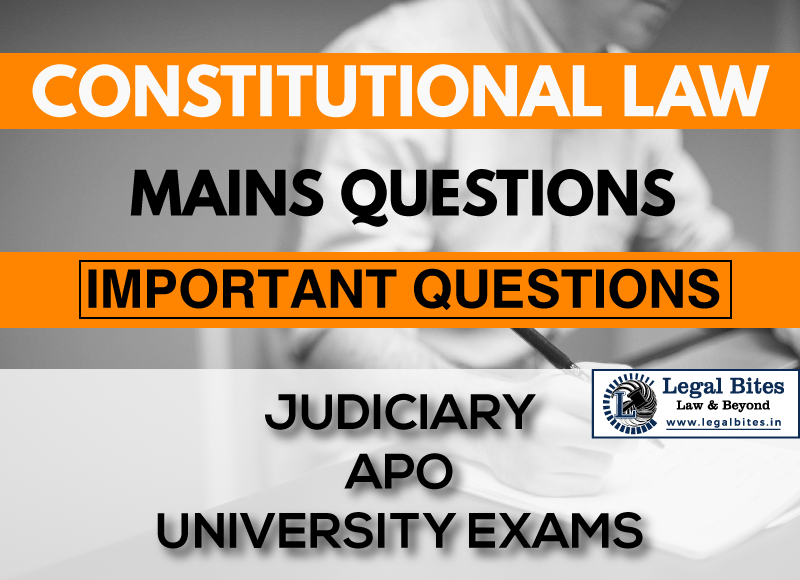Explain ‘Rule against Bias’. Discuss the various types of ‘Bias. Cite decided cases, where necessary.
Question: Explain ‘Rule against Bias’. Discuss the various types of ‘Bias. Cite decided cases, where necessary. [BJS 2017] Find the answer to the mains question only on Legal Bites. [Explain ‘Rule against Bias’. Discuss the various types of ‘Bias. Cite decided cases, where necessary.] Answer Rule against bias is one of the three principles of Natural Justice. The… Read More »

Question: Explain ‘Rule against Bias’. Discuss the various types of ‘Bias. Cite decided cases, where necessary. [BJS 2017] Find the answer to the mains question only on Legal Bites. [Explain ‘Rule against Bias’. Discuss the various types of ‘Bias. Cite decided cases, where necessary.] Answer Rule against bias is one of the three principles of Natural Justice. The rule is based on a famous maxim, Nemo debet essc judex in propria causa, which means that no one should be a judge in...
Question: Explain ‘Rule against Bias’. Discuss the various types of ‘Bias. Cite decided cases, where necessary. [BJS 2017]
Find the answer to the mains question only on Legal Bites. [Explain ‘Rule against Bias’. Discuss the various types of ‘Bias. Cite decided cases, where necessary.]
Answer
Rule against bias is one of the three principles of Natural Justice. The rule is based on a famous maxim, Nemo debet essc judex in propria causa, which means that no one should be a judge in his own cause i.e., there should be no bias. This is called Doctrine of Bias. The principle is that a judge is disqualified from determining any case in which he may, or may fairly be suspected to have an interest in the subject matter. The underlying principle is that justice should not only be done but should manifestly and undoubtedly be seen to be done.
In the case of A.K Kraipak v. Union of India [A.I.R. (1970) S.C. 150], the facts show that one of the members of a selection board constituted to make the selection to a Central cadre, was also a candidate for the interview. After the interview, the name of the candidate appeared at the top of the list. This was challenged as infringing the principles of natural justice. It was held that as the member was one of the persons to be considered for selection it was against all canons of justice to make him judge of his own cause.
Though he did not participate in the deliberation of the committee when his name was considered, his presence in the selection board must have had its own impact on the decision of the board. The Supreme Court also declared that there need not be any actual deliberation to make it invalid, since the interest of the appellant was involved in the selection process to keep his position safe.
Bias can be categorized into four categories.
a. Personal Bias
Personal bias arises from a certain relationship between the adjudicating authority and of the parties. In the case of Jiwan K. Lohia v. Durga Dutt Lohia [(1992) 1 SCC 56], the apex court observed that with regard to the bias the test to be applied is not whether in fact, the bias has affected the judgment, but whether a litigant could reasonably apprehend that a bias attributable might have operated against him in the final decision.
b.Pecuniary Bias
Where the judge of the case is shown to have a pecuniary interest in the results of the proceedings, it comes under pecuniary bias. In Jeejeebhoy vs. Astt. Collector, Thana [AIR 1965 SC 1096] the CJ reconstituted the bench when it was found that one of the members of the bench was the member of the cooperative society for which the land has been acquired.
c. Subject-matter Bias
A person shall also be disqualified from acting as a judge if he himself is a party or has some direct connection with the litigation, so as to constitute a legal interest. In Gullapalli Nageshwara Rao v. APSRTC [AIR 1959 SC 308], the Supreme Court quashed the decision of the A.P. government on nationalizing road transport on the ground that the Secretary of the transport department who was given a hearing was interested in the subject matter.
d. Department Bias
When the function of judge and prosecutor are combined in one department then such department shall be deemed to have a departmental bias. In Gullapalli Nageswara Rao’s case, one of the grounds for the challenge was that the Secretary of the Transport Department who gave the hearing was biased, being the person who initiated the scheme and also being the head of the department whose responsibility it was to execute it. The court quashed the order on the ground that, under the circumstances, the Secretary was biased, and hence no fair hearing could be expected.
Important Mains Questions Series for Judiciary, APO & University Exams
- Constitutional Law Mains Questions Series Part-I
- Constitutional Law Mains Questions Series Part-I
- Constitutional Law Mains Questions Series Part-II
- Constitutional Law Mains Questions Series Part-IV
- Constitutional Law Mains Questions Series Part-V
- Constitutional Law Mains Questions Series Part-VI
- Constitutional Law Mains Questions Series Part-VII
- Constitutional Law Mains Questions Series Part-VIII
- Constitutional Law Mains Questions Series Part-IX
- Constitutional Law Mains Questions Series Part-X
Admin Legal Bites
Legal Bites Study Materials correspond to what is taught in law schools and what is tested in competitive exams. It pledges to offer a competitive advantage, prepare for tests, and save a lot of money.

